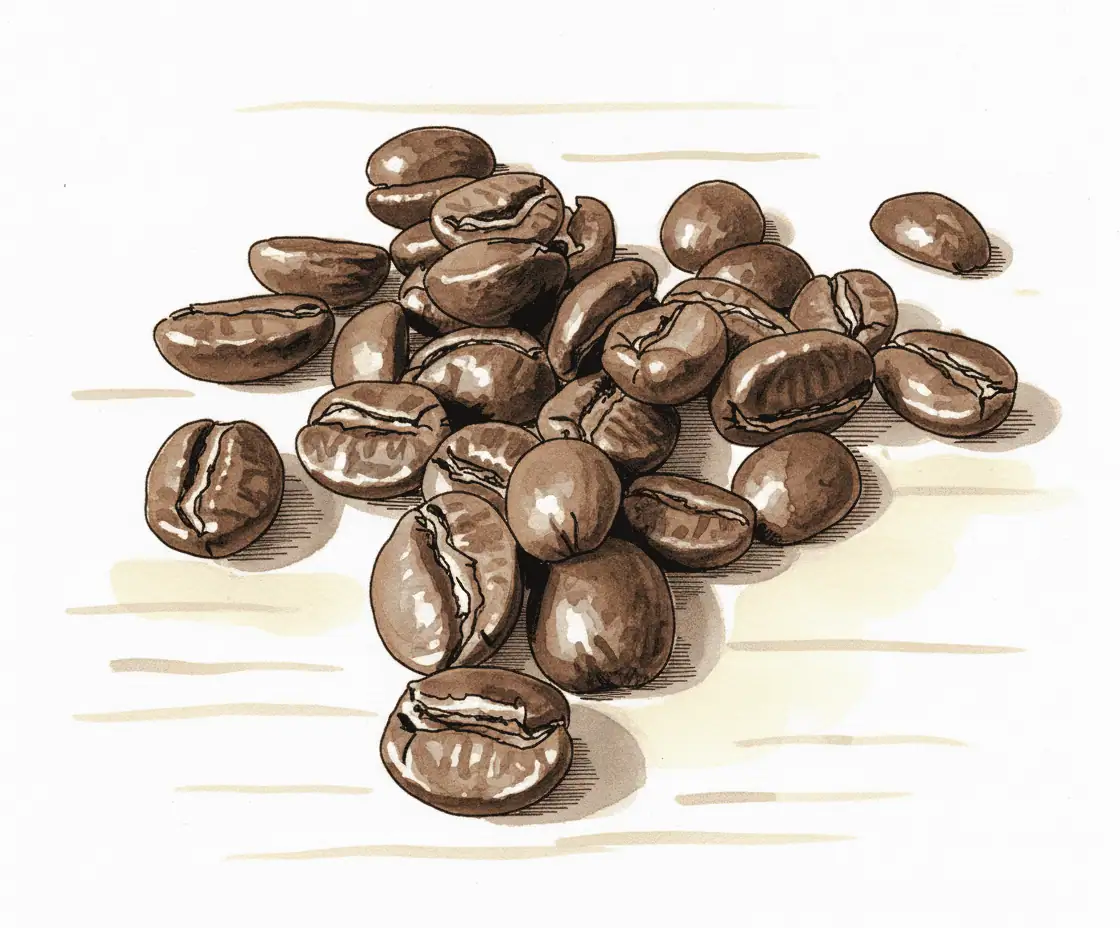Average altitude
Mid altitudes (around 1200–1500 meters) produce beans that offer a balance between sweetness and acidity. Growing conditions are still mild, yet the beans often develop more refinement than at lower elevations. This results in a brighter flavor profile, sometimes with subtle fruit or floral notes. Mid-altitude regions are common in countries such as Colombia, Mexico, and parts of Central America.
Beans

(New) Brazil Fazenda Monte Belo
Brazil Fazenda Monte Belo komt uit Minas Gerais, waar glooiende heuvels en een gemiddelde temperatuur van 18 °C zorgen voor stabiele groei. De blend is gebaseerd op Bourbon en is iets donkerder gebrand voor een volle, mollige body. Verwacht zachte zoetheid, tonen van chocolade en nauwelijks zuurgraad. De koffie is breed inzetbaar: heerlijk als espresso…

Ana Restrepo
Ana Restrepo verbouwt specialty koffie in Vereda Totoró, Sevilla, op 1500 meter hoogte. De vulkanische bodem en gerichte investeringen in fermentatie, vochtcontrole en Afrikaanse droogbedden verhogen de constante kwaliteit. De lichte tot medium branding bewaart zachte fruittonen en brengt marsepein, honing en rode appel naar voren, met een volle body als donkere chocolade. Zowel de…

Ana Restrepo Natural
Deze specialty koffie komt van de familieboerderij van Ana Restrepo in Vereda Totoro, Sevilla, Valle de Cauca, op 1500 tot 1620 meter. De natural verwerking en verbeterde droogbedden leveren aroma’s van aardbei, kers en donkere chocolade, met hints van marsepein, honing en rode appel. Het mondgevoel is romig met volle body. Sinds 2021 wordt per…

Arcila, Colombia Decaf
Deze decaf uit Quindio Colombia is geproduceerd door Jairo Arcila, derde generatie koffieboer, met export en selectie via Cofinet. De bessen drogen natuurlijk en worden vervolgens gedecafeineerd met suikerriet EA, een milde methode die aroma en zoetheid behoudt. Verwacht tonen van bruine suiker, molasse, gedroogde vijg en honing, aangevuld met fruitige accenten zoals passievrucht en…

Bant Sawk
Bant Sawk uit Taunggyi in Southern Shan is een specialtykoffie met een natural proces, die boeren een eerlijk alternatief voor opium biedt. Sinds 2017 werken de dorpen met Indigo Mountain en This Side Up aan kwaliteit en traceerbaarheid, met prijzen in 2019 voor beste naturals. Verwacht een heldere, zoete cup met tonen van aardbei, framboos,…

Bio Blend
Bio Blend is an organic and fairtrade Arabica blend from Honduras and Colombia, grown at 800 to 2350 meters. The medium-dark roast profile delivers a powerful espresso with preserved chocolate and fruit flavors, including raisins and a hint of orange, with a smooth finish. The washed processing ensures clear flavors and balance between body and smoothness...

Bittersweet Symphony
Bittersweet Symphony is een medium donker gebrande blend uit Brazilië, Colombia, Tanzania en Indonesië. De bonen komen van Minas Gerais, Huila, Mount Kilimanjaro en Java en worden natural, gewassen of wet hulled verwerkt. In het kopje proef je pure chocolade, geroosterde noten en frisse citrus met grapefruit, een volle body en mooie balans. Elke week…

Brasil Capricornio Pioneiro
Capricornio Pioneiro komt uit het zuiden van Sao Paulo en Parana, geproduceerd door een netwerk van boeren die inzetten op duurzame teelt en transparantie. De multivarieteiten Arabica worden verwerkt met het honingproces, wat zorgt voor romige tonen van pure chocolade, nougat en macadamia. In de Special Roast komen ook gedroogde bessen en zachte fruitzuren naar…

Brasil Santos
Brasil Santos komt uit Brazilië, vooral via de haven van Santos, en staat bekend om een milde en consistente smaak. De bonen groeien op lage tot middelhoge hoogtes in Minas Gerais en Sao Paulo. Het profiel is nootachtig, chocoladeachtig en licht honingachtig, met lage zuurgraad en een zachte body. Meestal gaat het om 100 procent…

Brasil Yellow Bourbon
Blooss Coffee Brasil Yellow Bourbon komt uit Minas Gerais, waar de variëteit sinds de jaren dertig wordt geteeld. Het brandprofiel varieert van medium tot donker en levert smaken van chocolade, noten, delicate bessen en honingzoet, met een volle, toegankelijke body en milde zuren. De bonen worden vaak natuurlijk of honey verwerkt, wat zorgt voor fruitige…

Brazil
Brazil Cascavel Verde is een 100 procent Arabica blend uit een Braziliaanse coöperatie op 800 tot 1100 meter. De koffie scoort SCA 84 en biedt klassieke tonen van amandel, donkere chocolade en karamel. Het gebrandprofiel leunt naar medium donker met milde bitterheid, een neutrale body en een frisse, zachte afdronk. Ideaal voor espresso en ook…

brazil – serra negra
Serra Negra is a single-origin Arabica from Minas Gerais in Brazil. White Label roasts it medium, with one profile for espresso and filter so the full chocolate tones and creamy notes are preserved. In the aroma there are dark chocolate, macadamia and pecan, with a subtle hint of citrus. The natural processing gives a sweet body and mild fruitiness…

Brazil - Campo Alegre Espresso
Brazil Campo Alegre Espresso komt van Fazenda Campo Alegre in Sul de Minas, op 1200 m hoogte met stabiel klimaat. De branding is gericht op espresso en levert volle body, romige textuur en tonen van donkere chocolade met fruitige zoetheid. De natural verwerking en variëteit Yellow Catucai zorgen voor balans en lage zuurgraad. De boerderij…

Brazil – Fazenda Santa Cruz
Fazenda Santa Cruz ligt in Caconde, Sao Paulo, waar sinds de jaren 1950 koffie wordt verbouwd. Op 960 hectare, met 180 hectare natuurreservaat, groeien arabicavariëteiten als Mundo Novo, Arara, Catuai, Catucai, Paraiso en Bourbon op 1000 tot 1200 meter. De bonen worden natural en pulped natural verwerkt, wat zorgt voor honingzoetheid, lage zuurtegraad en een…
Mid-Altitudes (around 1200–1500 meters)
Looking for a beautiful balance between sweetness and acidity in the cup? Then beans from mid-altitude regions are a great choice. These areas are common in countries like Colombia, Mexico, and parts of Central America. Here you get the best of both worlds: enough coolness for a refined taste, yet enough warmth for good sugar development.
How altitude affects espresso flavor
At elevations of roughly 1200 to 1500 meters, coffee cherries still ripen more slowly than at sea level, but not as slowly as at very high altitudes. This creates a balanced espresso: a mildly sweet base, often with subtle fruity or floral hints, alongside a pleasant, not overly dominant acidity. These coffees are known for their approachable yet refined character. They are often ideal for those who enjoy an espresso with a clear flavor, but without the sometimes “sharp” edge of very high-grown beans.
Chemical composition: balance of sugars and acids
Mid altitudes still give the coffee plant enough coolness to build complexity, yet enough warmth to encourage sweeter notes. The beans generally have a slightly lower density than true high-grown beans, but remain firm enough to develop a wide flavor palette. You will notice the acids are a touch less pronounced, allowing the sweetness to come forward. This can yield a balanced cup of espresso with both freshness and a soft body.
Processing methods: diversity is key
In many regions at these elevations, there is active experimentation with different processing methods. The washed method remains popular, but honey and semi-washed processes are also often used, depending on local traditions and the desired flavor profiles. Thanks to slightly higher temperatures (compared to high mountains), sun-drying beans is often easier. This allows farmers to apply natural or pulped natural methods, which in turn leads to more sweetness and sometimes a hint of fermentation in the taste.
Climate and microclimate
At 1,200 to 1,500 meters, conditions usually mean mild temperatures, regular rainfall, and still plenty of sun. This kind of environment is ideal for coffee shrubs. They are protected from extreme heat, but also from the cold of great heights. As a result, the growing season is stable and fairly predictable. Microclimates arise from local variations in rainfall and hours of sunshine. A shrub on one mountainside can therefore produce slightly different flavor nuances than one on the slope next to it.
Yield and resilience
In general, the yield here is better than at very high elevations, because the plants are less stressed by colder nights or thin air. This means farmers can often produce slightly higher volumes while quality remains high. Moreover, the shrubs can often stay healthy for longer, provided they are well maintained. A stable yield is beneficial for the local community, as farmers’ income is less dependent on erratic harvests.
Choosing coffee varieties
In this altitude band, many Arabica varieties are found, such as Caturra, Colombia, and Bourbon. Farmers often choose plants that strike a good balance between yield and flavor. Some varieties are resistant to diseases like "coffee leaf rust", which is an important factor in areas with higher humidity. This allows farmers to grow with confidence, knowing they will harvest consistently tasty coffee.
Coffee from mid-altitudes is therefore highly recommended for anyone seeking a balanced espresso. Expect subtle fruit or floral notes, complemented by a mildly sweet body. No sharp extremes, but a rich, approachable flavor that many drinkers appreciate.
A selection for those who are open to a lively and complex coffee experience.
